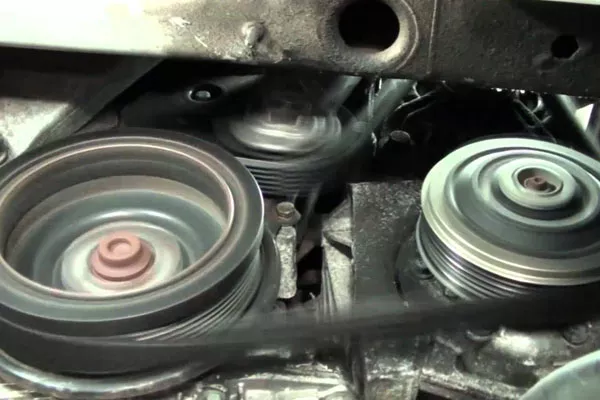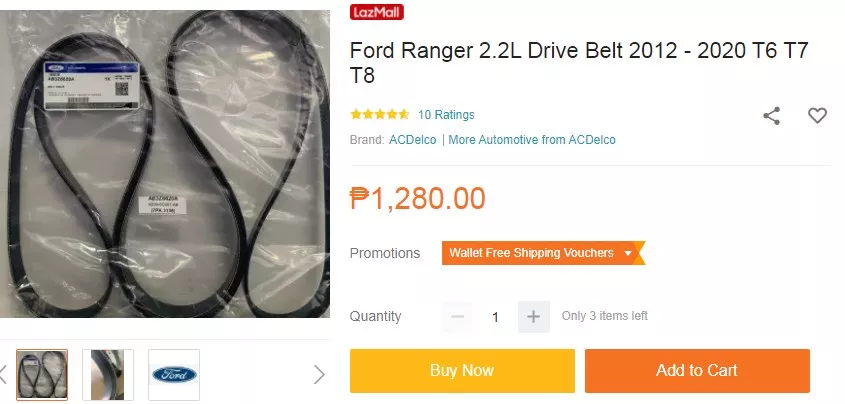Any form of noise is considered a pollution. Why? Because noise can be irritating, annoying and makes you want to scream just to stop wherever it’s coming from. Your apartment is so noisy right now that the only place where you can find your solitude is whenever you’re driving your car.
Everything goes smoothly and quietly and the only sounds you can hear are the soft sound of the air flowing through the air conditioning system, your favorite song on the stereo and your diva-like singing voice.

Squeaking sound from under the hood surely can be annoying and irritating - check your car's belts for this issue
One day, as you were enjoying your solitude, suddenly you hear a squeaking sound coming from under the hood. You now say, “What????” You parked your car in a safe location, let your engine run, popped the hood and see where the squeaking sound is coming from. Oh no, it’s the fan belt. Now, your place of solitude has also been infected with noise.
Don’t fret out, if you can’t do anything with the noises in your apartment, as car owner, you can definitely do something about your squeaking fan belts. We at Philkotse.com are here to help you on how to deal with and put a stop to these noisy fan belts.
I. What Are Drive/Fan Belts?
Overview
A fan belt or also known as drive belt or serpentine belt is a belt made of flexible rubber that is responsible for putting together several engine components such as crankshaft pulley, alternator and engine cooling fan so they could work together properly.
Belts are also used to make other components work such as A/C compressor, water pump and power steering pump. In the more recent years, the numbers of belts used in a car’s engine has lessened, as compared to older Japanese cars that uses more and various belts to operate several engine components.
Fan belt price in the Philippines
Prices of fan belts vary depending on car models. According to some popular local e-commerce platforms, fan belt price in the Philippines ranges from around Php 1,200 to Php 2,000.

Fan belt price on the market starts from around Php 1,200
II. Is it Time To Replace Your Fan Belt?
First, any car owner should not take the fan or drive belts for granted. As these belts pull together several engine parts, then it should also be one car part that should be cared for so the engine runs properly.
Therefore, as car owners, it is very important for you to know the signs of a faulty fan or drive belt. You don’t want to wait for any worse things to happen before paying attention to this important car part.
Here are the signs that your drive belts could be faulty and already needs replacing:
1. Steering the wheel has become more difficult than ever
Used to turn the wheel smoothly and with ease then suddenly it becomes like an arm wrestling match? Then it could be a sign that your fan belt is already faulty and needs replacement. It could possibly be that the fan belt is already losing its grip and slipping away.

Tough to handle steering wheel is one sure sign that you have a failing drive belt
Since this belt is broken, the engine misses the help coming from the water pump that is also responsible for driving the power steering belt.
2. The cabin light goes on and off
Since the belt is already losing its grip, you may notice that your cabin lights and even headlights will dim whenever you start the car. This is due to struggle in turning the alternator.
3. Start Up Problem
Since there’s already difficulty in turning the alternator because the belt is already losing its grip, there’s a high possibility of a start-up issue. Sometimes, the car engine cannot start at all.

A faulty drive belt can also cause a lot of start up issues
4. Engine temperature rises up
Since the belt doesn’t turn the water pump properly, then this consequently affects the engine’s cooling system, therefore may cause overheating.
5. Squeaking sound
Squeaking sounds are made by belts that’s already been wearing out. If you hear any squeaking sounds.
Now that we already know the signs of a faulty fan belt, its time to know the things we can do as car owners so we can lessen the noise and care for our fan belts properly.
III. How to Care For Your Car’s Fan Belt (To Avoid Squeaking Too!)
As mentioned, your car’s drive belts are also vital parts of your car so we should also pay attention to it regularly. By doing so, you’re also ensuring that your engine turns correctly and preserve the health of your engine too.
Here are some very simple ways on how you can effectively take care of your squeaking and faulty drive belts:
1. Use a belt dressing
The belt dressing can be used, not to really fix a broken belt, but it can be used to prevent your belt from wearing out easily. Belt dressing is also known as belt conditioner, when sprayed on our engine belts, can cause them to soften and prevents them from drying out and slipping. Therefore, belt dressing can prolong the life of your fan belts.
It can also be easily applied. All you have to do is start your engine and keep it running on idle. Use the straw extension that comes with the dressing when you buy it – this is to ensure that the dressing will be applied directly only to the parts necessary.
Spray towards the inner lining of the belt quickly and make sure you don’t apply too much that you’d already be soaking the belt with the belt dressing.
2. Always check the alignment of your fan or drive belts
This is also an important and at the same time easy way to prevent your car belt from squeaking and wear and tear.

Always check if your car's drive belts are misaligned. They can cause wear and tear and squeaking sounds too
If this happens, call you mechanic so they can have your fan belts fixed as soon as possible. Stalling in resolving this can definitely affect the belt in a negative way.
3. Check for signs of wear and tear
These belts should last 60,000 – 100,000 miles. But it won’t hurt you to check the belts regularly and inspect it for damage.
If you see around three cracks in every inch of space then it’s a sure sign that you already need to have them replaced. Again, don’t stall the replacement so you won’t have any car trouble.
>>> Click here to get more helpful tips and advice for your car maintenance
Recent posts
- 4 essential things you need to know when maintaining car belts Aug 09, 2022
- Drive belts - What you have not known and what you need to follow Aug 17, 2022
- Replacing the accessory drive belt Aug 16, 2022
- How does a timing belt in your car engine work? Feb 19, 2021












